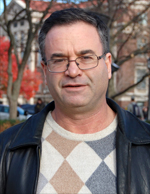The Quest for Quantum Information
2012-07-18

Professor - Physical/Theoretical and Computer Science
Imagine a world in which complicated, massive mathematical tasks -- say, the factorization of numbers with hundreds of digits -- could be solved in seconds instead of the years that it might take a classical computer to solve such a problem.
The practical implications of such speedy computing are many: improved drug design, better encryption technology to make our financial and other private data more secure, and perhaps even better weather prediction that could alert us faster and more accurately about an impending snowstorm
Those involved in quantum information research say that all of this could be reality if quantum computers become commonplace. Those developments are years away, but in the meantime, additional research -- as well as awareness and education -- is necessary to advance this complex branch of science.
That's why Purdue has helped establish a research center to study quantum information. The Quantum Information for Quantum Chemistry (QIQC) center, a National Science Foundation-sponsored Center for Chemical Innovation, seeks to understand chemistry from the viewpoint of quantum information, to develop techniques and quantum computers to solve important problems in chemistry and to inspire a new generation of scientists.
Purdue, along with Georgia Tech, Harvard, Haverford University and the University of Southern California, is involved in the effort. Sabre Kais, professor of physical and theoretical chemistry and computer science, is leading the collaborative effort. The $1.5 million Phase I NSF grant began in 2011.
Kais, who has been at Purdue since 1994, became interested in quantum computing because of its uniqueness and potential to solve problems that were unsolvable through present, more classical, methods.
"The first thing that interested me was the theory of entanglement, and the development of a more appropriate way to define electron correlation in quantum chemistry," he says.
The theory of entanglement states that after two particles become entangled, one particle can instantaneously affect the other, even if they are separated by a great distance.
Kais admits that the concept of quantum entanglement and the fundamentals of quantum theory are difficult for even some of the brightest scientists. Albert Einstein struggled with the entanglement, claiming that there exists "no physical intuition to understand it."
One of Purdue's objectives with the center is educational outreach. In fall 2011, 17 local teachers participated in a workshop. One of Kais' graduate students, Ross Hoehn, developed a quantum analogue of Tic-Tac-Toe that was used to demonstrate the concept of one object existing in two possible states at the same time, a concept central to quantum science.
"This is an excellent way to explain entanglement to teachers," Kais says. "They get excited about it and can take the game back to the classroom to get their students interested in it."
This summer, Kais will work with a student from Tippecanoe County's McCutcheon High School, who was inspired to pursue quantum research after learning about it from a teacher who attended the Purdue workshop.
Phase II of the NSF program would be a $20 million grant spanning five years that would more heavily focus on both expanding research to new fields and furthering the outreach element with science teachers.
Related link:
Source:
Purdue College of Science